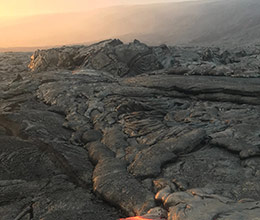Studying the Past to Understand Our Future
Unlocking the mysteries deep inside volcanoes
Give to the Research

Ask Joshua Schwartz what he does for a living and his answer is simple: “I study volcanoes.” The truth is more complicated. The CSUN geological sciences professor is more of a frontier man, traveling across continents to study the deepest parts of volcanoes. Within the “engine room” of a volcano is magma, responsible for creating Earth’s continental crust, from which crops, oil, gas and mineral resources are ultimately derived. Understanding how continental crust is formed helps us better predict our future.
However, getting to the interior of a volcano can be as impossible as it sounds. Instead, Schwartz and some of his students travel to Fiordland National Park in New Zealand to see a volcanic arc system that’s been tilted on its side, where they can study a section from its deepest to shallowest parts. Some of these findings come back to the classroom, so CSUN students can run their own research on samples from across the globe.
Working directly with students in the CSUN Laser Ablation Laboratory is among the reasons Schwartz chose CSUN as the place to conduct his research. “It’s important to me to inspire young geological scientists and get them excited about science,” he said. “We’re preparing the future generation of scientists in California.”
Inside the lab, students use high-tech instruments to date minerals and understand the tempo at which continental crust grows. This data informs the researchers about different time periods and the minerals and metal deposits that might be found in those areas.
Funding for Schwartz’s research provides a critical stipend for students, allowing them to pursue research opportunities and deepen their learning experience. It also supports the purchase of new instruments. “Major advances in my field come from applying new instrumentation to an old problem, or new ideas to an old problem,” Schwartz said.
Future geological scientists are created at CSUN. Your gift allows them to look to the past to better understand our future.